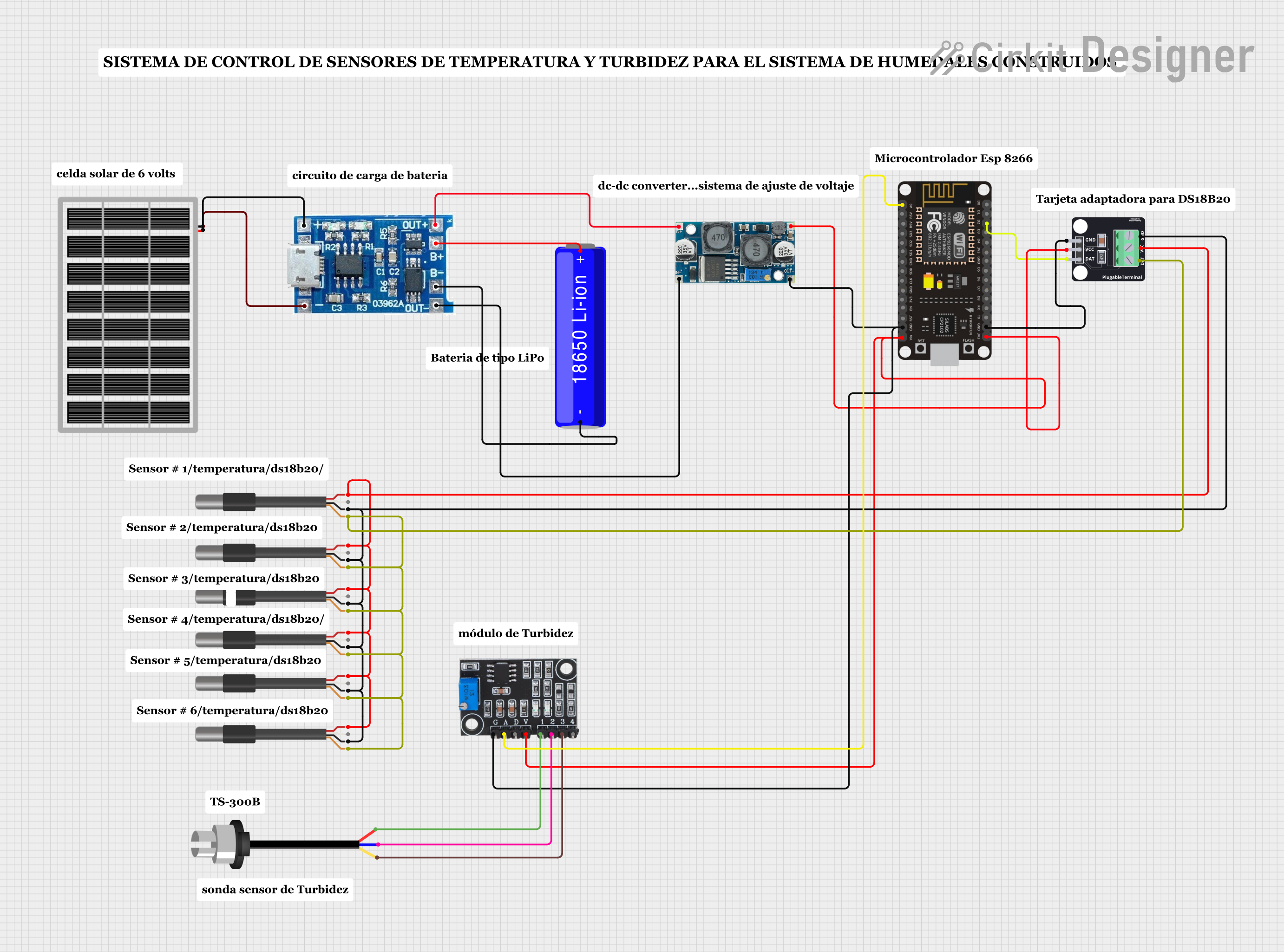
Cirkit Designer
Your all-in-one circuit design IDE
Home /
Project Documentation
Solar-Powered ESP8266 NodeMCU with Turbidity Sensing and Temperature Monitoring

Circuit Documentation
Summary
The circuit in question appears to be a solar-powered system designed to monitor environmental parameters such as temperature and turbidity. The solar panel charges a battery, which powers an ESP8266 NodeMCU microcontroller along with a turbidity sensor module and multiple DS18B20 temperature sensors. A voltage regulator ensures stable power supply to the components.
Component List
Solar Panel
- Description: A photovoltaic panel used to convert solar energy into electrical power.
- Pins:
gnd,vcc
Do solara (Solar Charge Controller)
- Description: Manages the power coming from the solar panel and charges the battery.
- Pins:
-,+,out+,out-,b+,b-
XL6009 Voltage Regulator
- Description: Boosts or steps up the voltage to a desired level.
- Pins:
OUT +,OUT -,IN +,IN -
18650 Li-ion Battery
- Description: Rechargeable battery that stores energy for the system.
- Pins:
-,+
ESP8266 NodeMCU
- Description: A microcontroller with Wi-Fi capability for controlling and monitoring the system.
- Pins:
D0,D1,D2,D3,D4,3V3,GND,D5,D6,D7,D8,RX,TX,A0,RSV,SD3,SD2,SD1,CMD,SD0,CLK,EN,RST,VIN
Module DS18B20
- Description: A digital temperature sensor module for measuring temperature.
- Pins:
GND,VCC,DAT
DS18B20 1-Wire Temperature Sensor Probe Cable
- Description: Waterproof temperature sensor probe with a digital interface.
- Pins:
shield,GND,DQ,VDD
Sonda Sensor Turbidez / Turbidity Sensor
- Description: A sensor for measuring the turbidity of a liquid.
- Pins:
S,-,+
Turbidity Module
- Description: An electronic module that interfaces with the turbidity sensor.
- Pins:
GND,AO,DO,VCC,S+,SO,S-
Wiring Details
Solar Panel
gndconnected to Solar Charge Controller-vccconnected to Solar Charge Controller+
Do solara (Solar Charge Controller)
-connected to Solar Panelgnd+connected to Solar Panelvccout+connected to Voltage RegulatorIN +out-connected to Voltage RegulatorIN -b+connected to 18650 Li-ion Battery+b-connected to 18650 Li-ion Battery-
XL6009 Voltage Regulator
OUT +connected to ESP8266 NodeMCUVIN, Turbidity ModuleVCCOUT -connected to ESP8266 NodeMCUGND, Turbidity ModuleGNDIN +connected to Solar Charge Controllerout+IN -connected to Solar Charge Controllerout-
18650 Li-ion Battery
+connected to Solar Charge Controllerb+-connected to Solar Charge Controllerb-
ESP8266 NodeMCU
VINconnected to Voltage RegulatorOUT +GNDconnected to Voltage RegulatorOUT -, Module DS18B20GNDD2connected to Module DS18B20DAT3V3connected to Module DS18B20VCCA0connected to Turbidity ModuleAO
Module DS18B20
GNDconnected to ESP8266 NodeMCUGNDVCCconnected to ESP8266 NodeMCU3V3DATconnected to ESP8266 NodeMCUD2
DS18B20 1-Wire Temperature Sensor Probe Cable
- Multiple instances of this component are connected in parallel:
GNDconnected to Module DS18B20GNDVDDconnected to Module DS18B20VCCshieldconnected to Module DS18B20DAT
Sonda Sensor Turbidez / Turbidity Sensor
Sconnected to Turbidity ModuleS--connected to Turbidity ModuleSO+connected to Turbidity ModuleS+
Turbidity Module
GNDconnected to Voltage RegulatorOUT -AOconnected to ESP8266 NodeMCUA0VCCconnected to Voltage RegulatorOUT +S-connected to Turbidity SensorSSOconnected to Turbidity Sensor-S+connected to Turbidity Sensor+
Documented Code
No code was provided for the microcontroller(s) in the circuit. Typically, the code would be documented here, including setup routines, main loop, and any interrupt service routines or additional functions. The code would also include comments explaining the purpose and functionality of each section or function.